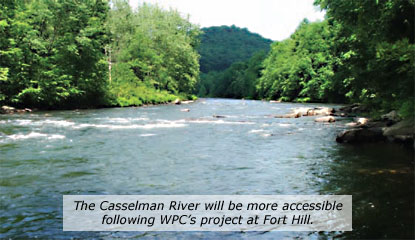New Fund Expands Access to Waterways for Canoeists and Kayakers
Thanks to the generosity of two longtime members, WPC is helping to keep pace with the surge in kayaking and canoeing — environmentally friendly recreational activities — by improving access to the region’s rivers and streams.
Established by outdoor enthusiasts Roy Weil and Mary Shaw, the Canoe Access Development Fund provides capital for projects that improve put-in sites or create new sites on waterways with Class 2 or 3 rapids. Weil and Shaw believe in the importance of connecting people to the natural environment through handson experiences, so this grant program supports outcomes that are important to them — and to WPC. The first grants from this fund were awarded in 2008.

“For years, we have enjoyed canoeing the many varied streams of Western Pennsylvania. Getting others out on the streams provides them a way to connect with the natural environment and appreciate the outdoors. We wanted to make it easier for ourselves and others to do this,” said Mary Shaw.
One current grant project will improve access to Pine Creek in Pine Creek Gorge, Tioga County, which is Canyon. The work there, at Gamble Run, will extend an access road through a meadow so paddlers can avoid having to walk down a steep hill to get to the water. This project and three others are slated for completion this summer:
- Avonmore on the Kiskiminetas River
- Fort Hill on the Casselman River
- Harris Bridge at Slippery Rock Creek
At Slippery Rock, boulders are being rearranged to provide a natural stairway to the southern reaches of the creek at the end of a dirt road in McConnells Mills State Park, while on the Kiskimenitas, an existing launch area is being made more accessible during low summer flows. The Casselman project involves creation of a parking area using Geotextile, a loose-cell fabric that provides both stability and good drainage, as a base. “Often, much of the work is done by volunteers, so we can fund more projects,” said fund coordinator Eli Long. “Kayaking and canoeing are relatively inexpensive ways to ‘recreate,’ and we want to make it easier and safer for people to get to the water. The more people spend time doing river activities, the more they care about the environment.”

For Shaw and Weil, recreation on the river and environmental stewardship go hand-in-hand. In addition to serving as canoeing instructors, they are recipients of outdoor stewardship awards from REI and Venture Outdoors. They are the authors of ”FreeWheeling Easy in Western Pennsylvania,” a guide to non-motorized trails, as well as “Linking Up,” a planning guide for trekking from Pittsburgh to Washington, D.C. In addition, they are the compilers of “Canoeing Guide to Western Pennsylvania” and authors of “101 Uses for a National Park Service Litter Bag.”
Weil said, “When setting up the fund we wanted to establish it with an organization that was committed to conservation, outdoors, water trails, and getting people engaged with the natural world; that had expertise in working with local landowners; that had been around for a while, and that was not dependent on the enthusiasm of one person. Given these criteria, the Western Pennsylvania Conservancy was the natural choice.”
Applications for Canoe Access Development Fund grants are accepted each year, beginning in late spring. For more information, contact Eli Long at 724-459-0953; extension 106 or elong@paconserve.org. To learn how you can help to expand this fund, contact WPC’s Development department at 412-586-2336 or development@paconserve.org.
Give your legacy roots
By including the WPC in your estate plans, such as through a bequest, a charitable gift annuity, or a gift of life insurance, you will ensure that our natural heritage is also a part of your future legacy.
